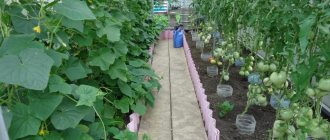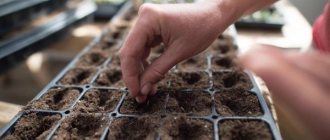The stereotype has long been ingrained that in order to enjoy juicy ripe watermelons and melons, you need to go to the Krasnodar Territory or somewhere else to the south. But that's not true. Even residents of the Urals and Siberia can easily grow their own melons, providing them with all the necessary conditions.
By the way, here are some excellent varieties of watermelon for Siberia: Ogonyok, Crimson Sweet, Siberian Lights. And here are the melons: Altai, Luna, Rosinka, Tender, Galileo, Kolkhoznitsa 749. Take note.
Is it possible to plant melons and watermelons together and at what distance?
Melons grow well next to each other, so they can be planted side by side. They need the same growth conditions:
- Since they originate from hot countries, they love the sun and warmth;
- They require approximately the same care;
- Cross-pollination usually does not occur.
But it is important to remember a few nuances:
- It is necessary to carefully calculate the planting site, since melons usually grow greatly. The distance between plantings should be at least 70 cm.
- In addition, they are susceptible to various diseases, so regular preventive measures should be taken as a rule.
Pollination
It is necessary to find large male flowers, pick them carefully, tear off the petals and place them on the stigmas of the female inflorescences. It is recommended to repeat this manipulation several times. The best time to do it is morning.
Do not delay pollination. The reason is that male inflorescences live very little. If female flowers lack pollination, then there is no point in waiting for fruit. Growing watermelons in a polycarbonate greenhouse is a great opportunity to get a high and tasty harvest. You should not hope that the melon will turn out to be large. As a rule, in a greenhouse, even with proper care, the fruits are average, but the taste is excellent.
Soil selection
The area for planting melons and watermelons should be reliably protected from the wind and well lit by the sun. The key to success is the right soil, providing the plants with a sufficient amount of necessary substances.
- The ideal option is sandy, sandy loam soil or light loam.
- The hydrogen content is important; it should reach 6-7 units.
- The soil for melons should be light, neutral, an abundance of various organic compounds is important.
- Excessive moisture and acidic soil are absolutely not suitable for growing melons and watermelons.
Planting watermelons and melons with seeds in a greenhouse or open ground
The earliest time for sowing melons is April, but in cold regions it may shift slightly towards summer. Residents of the southern regions should make sure that the nights are warm enough and the soil is well warmed up before planting.
If residents of cooler regions take up growing melons, it is better to stick to the seedling method.
Preparing seeds for sowing
Before planting, you can treat the seeds; as a result, not only does germination increase, but the seedlings also develop faster and are stronger and healthier. It also ensures the future ovary of female flowers, from which fruits are subsequently produced.
Treatment:
- First, you need to manually sort through the seeds and throw away any that are known to be defective. Then the seed material must be placed in a small cotton bag, which is soaked in hot water for three and a half hours.
- After this, the bag is transferred to a cool, weak solution of potassium permanganate for half an hour. This procedure will disinfect the seeds.
- The next step is to carefully remove the processed seeds with tweezers and place them on paper napkins, which are previously laid on the bottom of a plastic container. The napkins must be pre-moistened with settled water.
- The result was a kind of small greenhouse. It is left for a day and a half in a warm place, you can use the battery. After the specified period, the main spine will appear. After this, you can plant the seed either in open soil or in a greenhouse.
- You don’t have to process purchased seeds, since the manufacturer has already done all the necessary manipulations.
Sowing watermelons and melons with seeds in a greenhouse or open ground
First you should prepare the place where the melon plant will be located. An area on the south side of the site, well protected from the wind, is best suited. The site must be dry, without close groundwater.
You can artificially drain it by making beds up to 20 cm high and forming a slope towards the south.
There are two common sowing options - in furrows or holes. There should be a considerable gap between the seedlings - at least 70 cm, so that the seedlings do not interfere with each other and have enough space to grow.
- Planting in furrows . They should be located about a meter and a half from each other. A distance of 3-4 cm is maintained between the seeds. This option is usually used in regions with cold climates, where not all seeds germinate. If germination is good, the planting can then be thinned out or replanted.
- Planting in holes . In this case, it is necessary to maintain a distance of at least half a meter, or better yet, a meter. No less than 2 and no more than 5 seeds are planted in each hole. After sprouting, it is necessary to remove excess sprouts.
General recommendations by region
Today, melons are grown even in the Far East and Siberia. The main thing is to choose the right variety.
| Region | Growing method | Time for planting in the ground | Variety |
| Far East | Rassadny | May 20 – June 10 on raised beds | Early maturing, ultra early, mid maturing |
| Central Russia, southern part of the Urals, Bashkiria | Rassadny | April 20 – May 10 in the greenhouse May 10 – June 10 under film | Early ripening, mid ripening |
| South | Direct (to the ground) | April 15 – June 10 in open ground | All |
| North-West, Siberia | Rassadny | May 20 – June 20 in the ground April 1-20 in the greenhouse | Early, ultra early |
Caring for melons and watermelons after planting
A good harvest is possible only if the plants are cared for promptly and carefully. Do not neglect loosening the soil, weeding, and watering. It is important to apply fertilizers on time and take measures against diseases.
Watering
Watermelons and melons are moisture-loving plants. Their juiciness depends on timely and sufficient watering. There should be at least 30 liters of water per square meter, which must first be left standing for 24 hours.
Watering should be done once every seven days. If dry weather occurs, watering is done twice a week.
Additionally, it is necessary to irrigate the melons superficially, adding fertilizers. It is recommended to alternate feeding, using both fertilizers for the root system and shoots.
The more the fruits gain weight, the more watering is reduced. Finally, it should be stopped a week before harvest. This trick has a noticeable effect - sugar accumulates in the pulp during this time, as a result the fruit becomes very sweet and aromatic.
After watering, the soil must be loosened to prevent rapid evaporation of moisture.
Top dressing
This manipulation is carried out 14-15 days after sowing the seeds.
The first fertilizing is done with ammonium nitrate. There should be 20 grams per bucket of water. of this substance. The resulting solution in an amount of two liters is added to each well.
The second feeding is necessary when the formation of buds begins. During this period, 4 grams are needed for each plant. calcium chloride, the same amount of ammonium nitrate and 6 g. superphosphate.
What varieties are used for the middle zone
Variety “Ozhzhen” melon for the middle zone
Before growing watermelon in a greenhouse, you need to pay due attention to selecting the right varieties.
Advice. Early ripening varieties are suitable for central Russia. It is also not recommended to chase varieties with large fruits; they are not suitable for this region and can only realize themselves in appropriate conditions in the south.
What you need to know, as additional information:
- When buying fruits for growing, you must take into account the number of days from setting to ripening in the description.
- It is best to give preference to varieties that are capable of developing in the middle zone.
- You can ignore the shape of the fruit (if you are growing it for yourself).
Varieties for the middle zone:
- Pink champagne.
- Charleston near Moscow.
- A gift to the north.
- Creamstar.
One of the best melon varieties is "Cinderella", which has a sweet fruit and is easy to grow.
Planting watermelons and melons as seedlings in open ground or a greenhouse
Now let’s consider the option of growing melons using seedlings.
Seed preparation
To get a good result, planting material must be prepared in advance. Seeds should be purchased in early spring, at least two months before planting. An important nuance - preference should be given to seeds obtained five years ago.
When deciding on a variety, you need to take into account the climate. The colder the region, the more early ripening the variety should be.
It is ideal to focus on hybrids that already have adaptation to various unfavorable factors.
Purchased seeds must be checked for germination. To do this, you need to immerse them in a container of water. Those that float up are immediately thrown away, as there is no sprout in them. The remaining seeds can be planted in the ground to produce seedlings. Watermelon seeds have a harder shell, so germination time is much longer. To reduce it, you can pour boiling water over them.
First of all, the seeds need to be soaked. First, they must be sorted by variety, then wrapped in gauze, folded in several layers. All this is immersed in a container with a little water at the bottom. The seeds are soaked until the first shoots appear. If a lot of time has passed and the sprouts cannot be seen, the seeds can be postponed until next year. They should be dried and stored in the refrigerator.
Seedling growth
The next stage is preparing the pots. There should be as many of them as there are seeds. Containers need no more than 10 cm in diameter. They are filled with high-quality peat soil. You can add useful organic matter, such as humus, sawdust, and turf. These additives help retain heat, which is extremely important for melons.
Two hatched seeds are planted in each container, deepening them 5 cm. After this, the surface should be irrigated with a spray bottle, covered with a transparent film and kept warm. The pots are kept at a temperature of about +25 degrees from one month (melons) to one and a half months (watermelons).
After the sprouts appear, the film should be removed and the pot should be moved to the sun. A week after planting, mineral fertilizers are applied. At the same time, you can start preparing a tincture of mullein and superphosphates; it will come in handy in another seven days.
Choosing a place to plant watermelon and melon seedlings in the ground
Growing melons requires a lot of patience and attention. Close attention should be paid to the area. If you cannot find a sufficiently warm, sunny, wind-protected place, then it is better to use a greenhouse to get a good harvest.
Preparing seedlings for transplanting into soil
As soon as 5-7 leaves have formed on the seedlings, you can begin preparing to move them into the ground. The optimal time is the end of May. But if during this period the air temperature at night drops below 15 degrees, you should wait a few more days.
A week before planting, the hardening of the sprout begins. The plant is kept at temperatures from +16 to +20 degrees. This will give you the opportunity to gradually get used to the new conditions.
Scheme of planting seedlings of watermelons and melons and open ground or greenhouse
The comfort of the plant will ensure a good harvest. To get it, you need to follow a few simple rules:
- Care should be taken when preparing the site. The holes are made at a distance of at least 50-70 cm. Approximately 70 cm should be left between the rows.
- The holes are staggered, which gives access to each plant and room for development.
- When planting, the top leaves are left outside, the soil around the sprout is compacted and sprinkled with a layer of sand. This is necessary to prevent rotting.
- After planting, the sprout is watered with warm, settled water.
For the first few days, each sprout is covered with a moistened plastic cap. Weak and tender seedlings are initially very sensitive to aggressive sunlight.
Caring for watermelons and melons after planting seedlings in the ground
After the seedlings are planted in the soil, they should be sprinkled with a little sand. For several days after transplantation, the plants take root; during this period they need to be slightly shaded and watered with heated water every day. Watering is gradually reduced.
Fertilizer application takes place in three stages.
- Seven days after landing. To do this, approximately 25 grams are dissolved in a bucket of water. ammonium nitrate, 50 gr. superphosphate, about 20 g. potassium nitrate.
- During the period of lash formation. Mullein should be added to the water, keeping a proportion of 1:10 or chicken manure (1:20), add 20 grams. superphosphate and 30 gr. potassium salt.
- The third feeding is done when the first fruitful ovaries appear. Add 15 grams to a bucket of water. ammonium nitrate, 30 gr. potassium nitrate and 10 gr. superphosphate.
Melons have no problems with pollination. This is facilitated by about 150 different species of insects, including ants. Many gardeners, not knowing this fact, strive to destroy ants, thereby reducing the possibility of pollination.
Preparing seeds for sowing
Seeds that are pre-selected and tested for germination are prepared for planting. To get strong and healthy seedlings, it is recommended to prepare the seeds before planting.
Preparatory activities:
- Disinfection. This procedure is aimed at preventing disease. The seeds are immersed in potassium permanganate (concentration 0.5–1%) for half an hour. Then dry it by spreading it on a cloth napkin.
- Warming up. The seeds are kept for half an hour in water heated to 45 °C. After this procedure, the seeds germinate better. The main thing is not to overheat them. The second option is to warm the seeds in the sun for a week. The heated seeds are immersed in Cytovit or Zircon (2 liters - 1 ampoule).
- Scarification. The essence of the procedure is piercing the seed shell. Germination accelerates significantly. The procedures are carried out 2-3 weeks before sowing.
- Soaking in nutrient solution. To increase yield, seeds are soaked in a solution of microelements. The solution contains manganese, boron, molybdenum. The concentration of the solution is 0.05. Exposure time – 16 hours.
- Germination. To make the seeds germinate faster, they are germinated by wrapping them in a wet cloth. Ambient temperature - +20–25 °C. The fabric is regularly moistened - it should not dry out. During the day, the top layer is removed several times for ventilation. As soon as the sprouts appear, sowing work begins.
Formation of melons
After the first two or three fruits appear on the watermelon shoot, the central lash is pinched. The lateral ones are also subjected to this procedure over the fifth or sixth sheet. All other ovaries will draw resources onto themselves, interfering with development, so they should be removed.
Scheme of watermelon formation
Melon formation diagram
The central strand of the melon also needs to be pinched. This is usually done over 3-4 sheets. Side shoots should be carefully examined and the two strongest ones should be preserved. They also need to be pinched, doing this over 5-6 sheets.
After the ovary has formed, another pinching is carried out over 3-4 leaves above the ovary. Weak shoots are removed. The optimal number of fruits on one shoot is no more than 5-6 pieces.
You can organize the formation on a trellis. The lash needs constant tightening, because watermelons quickly gain weight. The fruits must be hung in a convenient net to reduce the load on the plant.
Planting material
In order for the harvest to be sufficient, it is necessary to choose the seed correctly.
Tip: Seeds taken from a purchased watermelon may not germinate at all. It is better to make a choice in favor of fast-ripening seeds.
Before you start growing watermelons in your dacha, you need to decide whether the local climate is suitable for this crop. The varieties are selected according to the climatic conditions. Before planting in the ground, the seeds are calibrated. Dry and empty ones are removed from the seed lot. To make the process faster, the seeds are placed in a bowl of salt water, in which unsuitable specimens will float to the surface.
The seeds are selected large, with a pointed end. After the salty liquid, the seeds are rinsed. To prevent seedling disease in the early stages, the seeds are sprayed with a manganese solution.
Pests of watermelons and melons
| Name | Harm caused | Way to fight |
| Aphid | Colonies of these insects are located on the leaves and destroy the ovaries and flowers. Aphids spread especially actively when the weather is warm and fairly humid. | Garlic, onion or mustard infusion gives good results. To prepare it, 300 gr. add a bucket of water to the onion and leave overnight. Then the product is filtered and the affected plants are treated. |
| Wireworm | These pests are small brownish worms covered with a hard shell. They live in the soil and cause severe damage to the root system. | Wireworms live on the roots of perennial weeds, so it is important to weed the area in a timely manner. Plants such as mustard greens or beans repel them well. |
| Fall armyworm | It develops in two generations, the caterpillars overwinter in the soil, rise to the surface in the spring, and pupate in the upper layers of the soil. At the end of May, the butterflies begin their flight, which lay eggs from which caterpillars grow. | The armyworm is a nocturnal insect, so you need to collect their caterpillars at night using a bucket of soapy water. You need to do this all summer, twice a week. |
| Spider mite | The tick loves dry, hot weather. It affects the leaves, on which light-colored spots appear. | You should carefully inspect the leaves. If affected areas are found, they must be removed and burned. |
Important
How to find out the ripeness of a melon?
The first sign of ripeness is a thick stem. The second is a crust that slightly collapses under pressure. An unripe melon is hard as a rock, while a ripe one gives in a little. However, here it is important not to overdo it, not to overcook the fruit: if it is too soft, it will rot. The third sign of a ripe melon is its characteristic light, pleasant aroma. And finally, the sound when you tap your knuckles on a ready-to-eat melon is always dull.
Before practicing on your greenhouse melons, try all these techniques on a known good melon, such as one from the supermarket.
A ripe watermelon has a smooth and shiny skin. The top layer, called the zest, can be easily removed with a sharp object. A ripe watermelon, squeezed in the palms, crackles slightly. And the side on which it lies has a yellowish tint - not white, and in no case green! And the tail of a ripened watermelon dries out a little.
Useful tips for growing watermelons and melons
Oxygen is extremely important for melons. To ensure its flow, it is necessary to carry out loosening. Its depth is at least 10 cm. After the appearance of side loops, regular hilling is introduced into the complex of care measures.
During active growth, melons often direct all their energy to the development of the fruit. For this reason, the plant suffers and weakens. To prevent this option, the main stem is pinched. It is necessary to ensure that no more than three full-fledged shoots develop on each plant; excesses should be removed in a timely manner.
Particular attention is needed during the period when the ovaries appear. No more than 6 of the strongest and strongest ovaries should be left, the rest should be removed.
During ripening, the load on the plant increases significantly, as there is a noticeable increase in mass. To protect the plant, the fruits are placed in a net and suspended. Foil must be placed under them, otherwise the fruits may begin to rot if they come into contact with the soil.
A week before harvesting, you should stop watering to get a juicy, sweet and aromatic watermelon or melon. It is necessary to remove fruits only after full ripening. The exception is transportation of the crop or expected long-term storage. Then you can pick unripe berries, so they will withstand long-term transportation well and have time to ripen.
Pre-landing activities
The main method of planting watermelon is by seedlings in a greenhouse.
That is why it is important to know which greenhouse is suitable for growing heat-loving crops
Choosing a greenhouse
Watermelon loves space, warmth and air. Preferred structures are at least 1.7 m high, optimally 2 m. The material for making a greenhouse should be durable, polycarbonate would be the best. The walls are well protected from drafts (cold air flows are unacceptable), but with comfortable windows. It is advisable to prepare a fireplace or other source of additional heating in the greenhouse in cold weather.
The best neighbors for this berry:
- peppers,
- eggplants,
- cucumbers
However, the best option would be a separate greenhouse specifically for watermelons.
When growing watermelons in a greenhouse, be sure to use substrates or nets - without them, heavy fruits may break off
Soil preparation
Watermelon needs neutral, fertile, nutritious, but not greasy soil. In autumn, the soil is dug up to a depth of 25 cm, loosened, rotted manure (2 buckets per square meter), nitrophoska (3 tablespoons), superphosphate (1 tablespoon) is added.
Pay attention to the technical characteristics of the soil. There are reviews that watermelons grow well in clay soil, but if there is at least a hint of a cold, damp summer, the soil should be well permeable to moisture and air
To do this, sand and rotted sawdust are added to it.
It is advisable to loosen the soil in the garden bed for watermelons in the fall.
Covering material for seedlings is prepared in advance in case of a sudden cold snap: spunbond or film.
Variety selection
This is a very important point - the wrong choice of seeds will result in a completely lost season. In Siberia and the Urals, only zoned varieties are grown. They should be:
- early ripening;
- small-fruited (very large watermelons will only have time to ripen in the southern regions);
- preferably produced by agricultural firms in the selected region.
The shelf life of seeds is 6–8 years if properly stored. Fresher seeds germinate faster, 3-4 year old seeds take longer.
Some varieties suitable for Siberia and the Urals and already tested by melon lovers:
- Ogonyok is unpretentious and early ripening, the fruits are small, up to 1.5 kg, the pulp is very sweet and tasty;
- Astrakhan XXXL - very fast growth rate, mid-season, difficult to grow in the conditions of Siberia or the Urals, although acceptable on average;
- Ultra-early - compact, with classic fruits, growing season - 80 days;
- Sugar baby - absolutely not capricious, thin crust, growing season - 75-85 days;
- Charleston near Moscow - original oval-shaped fruits, hybrid variety, from planting to fruit ripening - 80 days;
- Krasen is an extremely early hybrid, bred by crossing the Ogonyok and Super Sweet varieties, capable of bearing fruit in 65 days;
- Sibiryak-97 - bred specifically for Siberia; the fruits are larger than those of Ogonyok and can withstand short-term temperature drops to –4 °C;
- Lazyboka honey is a very sweet, sugar hybrid with a growing season of 75–90 days;
- Emperor's Cap is a hybrid with oval fruits resembling a torpedo melon in shape; growing season - 95–100 days; fruits weighing up to 10 kg;
- Helen is a hybrid variety from the USA, early ripening, 60 days before fruit ripening.











